The Shortest History of Ancient Rome
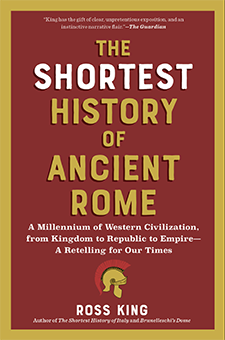 At its greatest extent, the Roman Empire encompassed more than twenty-five modern-day countries, stretching at its greatest extent from the Irish Sea to Mesopotamia. It flourished for some 500 years and, around the time of Christ, made up at least 20 percent of the world’s population. It has shaped our politics and laws, language and numerals, calendar and architecture.
At its greatest extent, the Roman Empire encompassed more than twenty-five modern-day countries, stretching at its greatest extent from the Irish Sea to Mesopotamia. It flourished for some 500 years and, around the time of Christ, made up at least 20 percent of the world’s population. It has shaped our politics and laws, language and numerals, calendar and architecture.
But what was Rome, who were the Romans, and why ultimately did the empire fall? Ranging across more than a thousand years, from the foundation myths of Romulus and Remus to the barbarian invasions, The Shortest History of Ancient Rome vividly explores the lives of murderous emperors, rebellious women, remarkable thinkers, fugitive slaves and persecuted Christians.
Read more about The Shortest History of Ancient Rome
Purchase from Amazon.com, Amazon.co.uk, Barnes & Noble, Bookshop.org, Booktopia (Australia) or Indigo (Canada)
 Monet: The Water-Lily Pond
Monet: The Water-Lily Pond
To celebrate its 200th anniversary in 2025 the National Gallery in London commissioned a short series of books on some of their most famous and beloved paintings—including this one on Claude Monet’s 1899 masterpiece The Water-Lily Pond. I look at how Monet came to construct his water lily pond beside his house in Giverny and then populate it with beautiful aquatic plants that he then spent much of the rest of his life cultivating and, of course, painting. The National Gallery’s painting represents one of his first attempts to come to terms with the motif that would obsess him for the last 25 years of his life—and that continue to obsess us today.
Purchase from The National Gallery Shop
The Shortest History of Italy
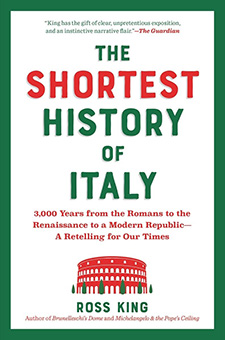 The calendar. The Senate. The university. The piano, the heliocentric model, and the pizzeria. It’s hard to imagine a world without Italian influence―and easy to assume that inventions like these could only come from a strong, stable peninsula, sure of its place in the world. In this breakneck history, bestselling author Ross King dismantles this assumption, uncovering the story of a land rife with inner uncertainty even as its influence spread.
The calendar. The Senate. The university. The piano, the heliocentric model, and the pizzeria. It’s hard to imagine a world without Italian influence―and easy to assume that inventions like these could only come from a strong, stable peninsula, sure of its place in the world. In this breakneck history, bestselling author Ross King dismantles this assumption, uncovering the story of a land rife with inner uncertainty even as its influence spread.
As the Italian tale unfolds, prosperity and power fluctuate like the elevation in the Dolomites. If Rome’s seven hills could talk, they might speak of the glorious time of Trajan―or bemoan the era of conquest and the Bubonic Plague that decimated Rome’s population. Episodes of wealth like the First Triumvirate and the time of the Medicis are given fresh life alongside descriptions the Middle Ages, the early days of Venice, the invasion of Napoleon, and the long struggle for unification.
With illustrations and maps to reinforce key details, King paints a vibrant portrait of a country whose political and cultural legacies enrich our lives today.
Read more about The Shortest History of Italy
Purchase from Amazon.com, Amazon.co.uk, Barnes & Noble, Bookshop.org or Booktopia (Australia)
The Bookseller of Florence: The Story of the Manuscripts That Illuminated the Renaissance
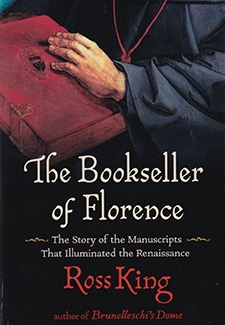 The Renaissance in Florence conjures images of beautiful frescoes and elegant buildings—the dazzling handiwork of the city’s artists and architects. But equally important were geniuses of another kind: Florence’s manuscript hunters, scribes, scholars and booksellers, who blew the dust off a thousand years of history and, through the discovery and diffusion of ancient knowledge, imagined a new and enlightened world.
The Renaissance in Florence conjures images of beautiful frescoes and elegant buildings—the dazzling handiwork of the city’s artists and architects. But equally important were geniuses of another kind: Florence’s manuscript hunters, scribes, scholars and booksellers, who blew the dust off a thousand years of history and, through the discovery and diffusion of ancient knowledge, imagined a new and enlightened world.
At the heart of this activity was a remarkable bookseller: Vespasiano da Bisticci, known as ‘the king of the world’s booksellers’. Besides repositories of wisdom by the likes of Plato, Aristotle and Cicero, his books were works of art in their own right, copied by talented scribes and illuminated by the finest miniaturists. His clients included popes, kings and princes from all across Europe who wished to burnish their reputations by founding magnificent libraries.
Vespasiano reached the summit of his powers as Europe’s most prolific merchant of knowledge when a new invention appeared—the printing press—that forever changed how books were produced and knowledge transmitted. By 1480, after almost fifty years in business, Vespasiano closed his shop in Florence’s Street of Booksellers and retired to the country to write his gossipy memoirs of everyone he had known.
A thrilling chronicle of intellectual ferment set against the dramatic political and religious turmoil of the era, The Bookseller of Florence is also an ode to books and bookmaking that charts the world-changing shift from script to print through the life of an extraordinary man—one of the true titans of the Renaissance.
Purchase from Amazon.com, Amazon.co.uk, Barnes & Noble, Bookshop.org or Indigo.ca
‘Magnificent … King’s meticulous research provides an immersive reading experience as he expertly weaves the political intrigue of families vying for power and currying favor with the pope into a riveting intellectual history covering the evolution of books, Renaissance Italy, classical philosophy and literature, and the invention of the printing press. A profoundly engaging study of a time when books were considered essential to a meaningful life, and knowledge and wisdom were cherished as ends in themselves.’
—Booklist (starred review)
‘In this fascinating biography, Canadian author King (Brunelleschi’s Dome) weaves Vespasiano’s story into the fabric of the tumultuous times in which he lived … The result is a narrative about a man and his books, and so much more, including the origins and history of the Frankfurt Book Fair and the influence of Johannes Gutenberg and his printing press on the arc of history. Standout narrative nonfiction that will engage bibliophiles and readers who enjoy historical nonfiction.’
—Library Journal (starred review)
‘A fascinating read … Though ostensibly a biography of Vespasiano, he is less the book’s subject than its method: a window on to the intellectual, political and technological developments of a time in radical ferment. It is an astute choice by King, just as King – entertaining, witty and expert – is a fortunate fate for Vespasiano’
—Tim Smith-Laing, Daily Telegraph (5-star review)
‘A marvel of storytelling and a master class in the history of the book, explaining sometimes arcane bookmaking process in clear and coherent language while lending an easy touch to otherwise confounding historical turmoil. The Bookseller of Florence is a dazzling, instructive and highly entertaining book, worthy of the great bookseller it celebrates’
—Ernest Hilbert, Wall Street Journal
‘The scope of King’s knowledge is staggering and his book bulges with facts. They are at their most enticing when they relate to physical processes such as the details of Vespasiano’s manuscript production … Remarkable as these feats of factual exposition are, King’s supreme ability is to imagine himself into the past … As King’s spectacular book shows, Vespasiano deserves to be remembered.’
—John Carey, The Sunday Times
Mad Enchantment: Claude Monet and the Painting of the Water Lilies
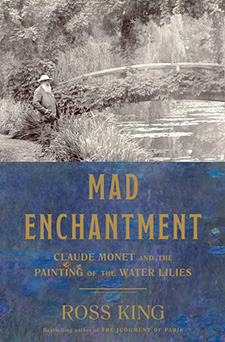
Claude Monet is perhaps the world’s most beloved artist. Among all his creations, the paintings of the water lilies in his garden at Giverny are the most famous. Seeing them in museums around the world, viewers are transported by the power of Monet’s brush into a peaceful world of harmonious nature. Monet himself intended them to provide “an asylum of peaceful meditation.” Yet these beautiful canvases belie the intense frustration Monet experienced at the difficulties of capturing the fugitive effects of light, shade, depth and color. Their calmness and beauty also conceal the terrible personal torments—the loss of loved ones, the horrors of World War I, the infirmities of age—that he suffered in the last dozen years of his life.
Mad Enchantment tells the full story behind the creation of the Water Lilies. The history of these remarkable canvases begins early in 1914, when French newspapers began reporting that Monet, by then 73 and one of the world’s wealthiest, most celebrated painters, had retired his brushes. He had lost his beloved wife, Alice, and his eldest son, Jean. His famously acute vision—what Paul Cezanne called “the most prodigious eye in the history of painting”—was threatened by cataracts. And yet, despite ill health, self-doubt, and advancing age, Monet began painting again, this time on a more ambitious scale than ever before.
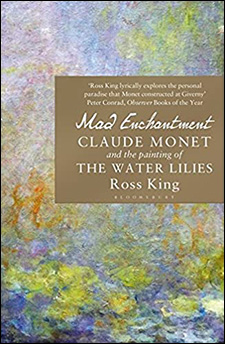
Linking great artistic achievement to the personal and historical dramas unfolding around it, Mad Enchantment presents the most intimate and revealing portrait of an iconic figure in world culture—from his lavish lifestyle and tempestuous personality to his close friendship with the fiery war leader Georges Clemenceau, who regarded the Water Lilies as one of the highest expressions of the human spirit.
- Winner of the 2017 RBC Taylor Prize
- Shortlisted for the Los Angeles Times Book Prize for Biography and the Hilary Weston Writers’ Trust Prize for Nonfiction
- Selected by Newsday as one of the 10 Best Books of 2016
‘Readers will rejoice at this critical and social “biography” of Monet’s stunningly ambitious final signature painting cycle, Water Lilies, a deeply immersive companion to the author’s memorable The Judgement of Paris … King is ever the brilliant docent murmuring the right, telling details and critical backstories in our ear as we move through space and time. He ultimately brings the man and his work into perfect focus while increasing his audience’s interest in both all the more.’
—Library Journal (Starred Review)
‘King effectively puts readers at the painter’s side as he rails against the impossible task he set for himself, suffering the “tortures” of painting and slashing canvases. As in his superb The Judgment of Paris (2006), about the rise of Impressionism, the author sets this fascinating portrayal of the larger-than-life artist—known equally for his “obstreperous temperament” and warm hospitality, for his love of gardening, family life, fast cars, and gourmet food—against a backdrop of the raging war, politics, history, and changing tastes in art. King elegantly reveals the soul of a great artist, the last Impressionist standing at the end of one of history’s most remarkable art movements.’
—Kirkus Reviews (Starred Review)
‘[A]n engaging and authoritative portrait of the aged artist and his travails … The Monet who emerges from King’s pages is a sympathetic and vivid character.’
—New York Times Book Review
‘Sensitive, deeply researched and altogether delightful.’
—Newsday
‘If beauty is in the eye of the beholder, then anyone who is not drawn into Mad Enchantment: Claude Monet and the Painting of the Water Lilies by Ross King is truly visually impaired … Mad Enchantment is a book to be read and enjoyed; it is a learning experience for those both learned and inexperienced in the world of art. Ross King does an exemplary job of bringing Claude Monet back to life. This one belongs on the bookshelf within easy reach.’
—New York Journal of Books
‘A fine, fluent book [and] a careful unpicking of cherished art-historical narratives.’
—The Guardian
‘Ross King has a track record when it comes to turning such art stories into gripping narratives … His method is expansive, including personal, political, social and cultural context.’
—The Sunday Times
Purchase from Amazon.com, Amazon.co.uk, Barnes & Noble or Bookshop.org
Florence: The Paintings & Frescoes
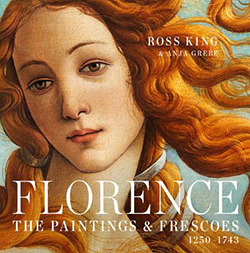 Florence: The Paintings & Frescoes is the most comprehensive book ever undertaken on the art of Florence, featuring more than 2,000 beautifully reproduced paintings from the city’s great museums and churches. The book illustrates every painted work on display in the Uffizi Gallery, the Pitti Palace, the Accademia, and the cathedral of Santa Maria del Fiore, along with many other works from 28 of the city’s other magnificent museums and churches that make Florence one of the world’s greatest treasure troves of painting.
Florence: The Paintings & Frescoes is the most comprehensive book ever undertaken on the art of Florence, featuring more than 2,000 beautifully reproduced paintings from the city’s great museums and churches. The book illustrates every painted work on display in the Uffizi Gallery, the Pitti Palace, the Accademia, and the cathedral of Santa Maria del Fiore, along with many other works from 28 of the city’s other magnificent museums and churches that make Florence one of the world’s greatest treasure troves of painting.
Ross King provides the social, historical and artistic background of the city and its paintings in short, informative essays, and Anja Grebe, author of The Louvre and The Vatican, offers detailed readings of individual paintings. Additional material is provided by Cristina Acidini (former Superintendent of the public museums of Florence) and Msgr. Timothy Verdon (Director of the Artworks for the Archdiocese of Florence).
Published by Black Dog & Leventhal.
Purchase from Amazon.com, Barnes & Noble or Bookshop.org
Leonardo and The Last Supper
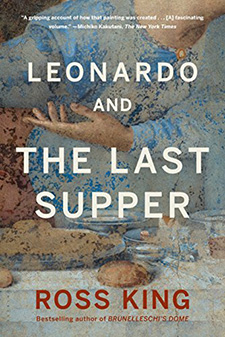
The behind-the-scenes story of the creation of one of history’s greatest masterpieces.
‘This is quintessential King territory, and his uniquely detailed, far-ranging, and engrossing chronicle of the creation of this revolutionary masterpiece … perfectly complements his best-selling Michelangelo and the Pope’s Ceiling (2003). Himself an exceptional portraitist and craftsman, King brings to precise life a fully dimensional, irresistibly audacious, and wizardly Leonardo and his powerfully affecting, miraculously surviving mural … Readers will love the dramatic, vivid, and brainy mix of biography and art history.’
—Booklist (starred review)
‘An absorbing study of a disappearing masterpiece … King places the painting in its political, social and artistic context, describing both the meaning of da Vinci’s work and the violent 15th-century Italian world that spawned it … King plumbs the painting’s religious, secular, psychological and political meanings, registered in the facial expressions and hand positions, the significance of the food on the table and, most fascinatingly, the salt spilled by the betraying Judas … King’s book is an impressive restoration—the author helps readers see this painting for the first time.’
—Kirkus (starred review)
Early in 1495, as a French army rolled through Italy, Leonardo da Vinci began work in Milan on what would become one of history’s most influential and beloved works of art—The Last Supper. After a dozen years at the court of Lodovico Sforza, the Duke of Milan, Leonardo was at a low point personally and professionally. Despite a number of prestigious commissions, he had reached the age of 43—more than the average life expectancy for the day—without having completed a major work that fulfilled his astonishing promise. His latest failure was a giant bronze horse to honour Lodovico Sforza’s father. After he had spent the better part of a decade planning the monumental sculpture, his 75 tons of bronze were expropriated to be turned into cannon to help repel the French invasion.
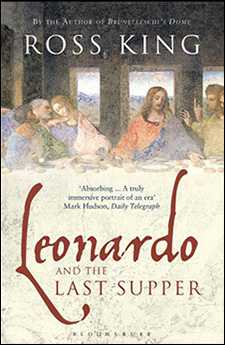
The commission to paint a religious scene in the refectory of a Dominican convent was a small compensation for Leonardo after this dispiriting loss, and his odds of completing the mural were not promising. Not only had he never worked on a painting of such a large size—15’ high x 30’ wide—but he had no experience in the extremely difficult medium of fresco. He therefore had to invent a new and largely untried method of applying his paints.
Leonardo and The Last Supper shows how despite being frustrated by war and political turmoil, and beset by his own insecurities and logistical difficulties, Leonardo created a masterpiece that would forever define his reputation. But this timeless masterpiece is also very much a document of its time and place. The book reveals dozens of stories embedded in the painting, from the food on the table—a dinner of eels—to the hand gestures of the Apostles and the models used by Leonardo, whose mural was intended to celebrate the Milanese court. As King shows, Leonardo even included his self-portrait among the Apostles.
Many of the myths that have grown up around The Last Supper are wrong, but its true story is even more intriguing. Bringing to life a fascinating period in European history, Leonardo and The Last Supper presents an original portrait of one of history’s greatest geniuses through the lens of his most famous work.
‘King gives us a gripping account of how that painting was created … [and] deftly situates the painting in a historical context — against political events in Italy at the time, religious attitudes of the day and contemporaneous developments in art — and also places it in the context of Leonardo’s career… [a] fascinating volume.’
—The New York Times
‘Ross King reveals the painting in a light that is novel and fascinating yet also scholarly. As with a previous title, Brunelleschi’s Dome (2000), his scrupulous excavation of social, political and religious texts, as well as art historical sources, permits him to tell a familiar story as though it had never been told before.’
—Financial Times
‘A meticulous telling of the genesis of Leonardo’s great fresco … The strength of his account lies in its mass of absorbing detail, which builds into a truly immersive portrait of an era.’
—Sunday Telegraph
‘King has the gift of clear, unpretentious exposition, and an instinctive narrative flair … an engaging and unusually intimate view of one of the great icons of western art.’
—The Guardian
‘A rich account … While the picture can no longer draw the viewer into the room shared by Christ and the apostles, King’s book does succeed in taking the reader into Leonardo’s vivid world.’
—The Sunday Times
‘King … has an infectious relish for the gaudy, brutal and brilliant world of the Italian Renaissance … Anyone wanting a vivid souvenir … should be perfectly content with a post-card and a copy of this engaging book.’
—Mail on Sunday
Purchase from Amazon.com, Amazon.co.uk, Barnes & Noble or Bookshop.org
 The Fantasia of Leonardo da Vinci
The Fantasia of Leonardo da Vinci
Leonardo da Vinci was a polymathic genius, but he was also playful, fanciful, funny—and often angry about the mistreatment of animals. Ross King shows the Leonardo behind the paintings, as the artist tells the tales he might have told at court and to friends over dinner, including fables about animals and a funny story about monks. King’s perceptive narrative guides us through this little-known Leonardo: his bestiary, fables, jests and riddles. It’s a revealing portrait of a Leonardo unknown to all but the most diligent and perceptive of scholars, beautifully illustrated with images from the Royal Collection at Windsor Castle.
Purchase from Amazon.com
Defiant Spirits: The Modernist Revolution of the Group of Seven
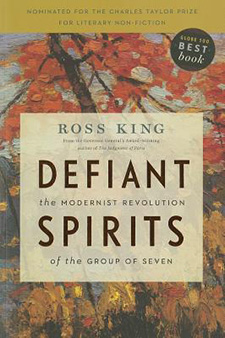 Beginning in 1912, Defiant Spirits traces the artistic development of Tom Thomson and the future members of the Group of Seven—Franklin Carmichael, Lawren Harris, A.Y. Jackson, Franz Johnston, Arthur Lismer, J.E.H. MacDonald, and Frederick Varley—over a dozen years in Canadian history. Working in an eclectic and sometimes controversial blend of modernist styles, they produced what an English critic celebrated in the 1920s as the ‘most vital group of paintings’ of the 20th century. Inspired by Cézanne, Van Gogh and other modernist artists, they tried to interpret the Ontario landscape in light of the strategies of the international avant-garde. Based after 1914 in the purpose-built Studio Building for Canadian Art, the young artists embarked on what Lawren Harris called ‘an all-engrossing adventure’: travelling north into the Canadian Shield and forging a style of painting appropriate to what they regarded as the unique features of Canada’s northern landscape.
Beginning in 1912, Defiant Spirits traces the artistic development of Tom Thomson and the future members of the Group of Seven—Franklin Carmichael, Lawren Harris, A.Y. Jackson, Franz Johnston, Arthur Lismer, J.E.H. MacDonald, and Frederick Varley—over a dozen years in Canadian history. Working in an eclectic and sometimes controversial blend of modernist styles, they produced what an English critic celebrated in the 1920s as the ‘most vital group of paintings’ of the 20th century. Inspired by Cézanne, Van Gogh and other modernist artists, they tried to interpret the Ontario landscape in light of the strategies of the international avant-garde. Based after 1914 in the purpose-built Studio Building for Canadian Art, the young artists embarked on what Lawren Harris called ‘an all-engrossing adventure’: travelling north into the Canadian Shield and forging a style of painting appropriate to what they regarded as the unique features of Canada’s northern landscape.
Sumptuously illustrated, rigorously researched and drawn from archival documents and letters, Defiant Spirits constitutes a ‘group biography’, reconstructing the men’s aspirations, frustrations and achievements. It details not only the lives of Tom Thomson and the members of the Group of Seven but also the political and social history of Canada during a time when art exhibitions were venues for debates about Canadian national identity and cultural worth.
‘King, an admirably industrious researcher and deft writer, splendidly braids together the lives of eight painters, the seven members of the Group and Tom Thomson. His skill and intelligence make Defiant Spirits an essential addition to any library of Canadian art history.’
—National Post
‘With his usual spirited prose and faultless research, King makes internationalists of the Group of Seven, showing them responding and reacting to the art of their day and the socio-political upheavals brought about by the First World War.’
—Canadian Art
‘In Defiant Spirits, Ross King tells the story of the Group of Seven as it has never been told before. He does for the Group what in his much-acclaimed books he does for Michelangelo, Brunelleschi, and Meissonier: sets out an articulate context, digs out a ton of new information, packs in lots of juicy details and tells a story elegantly and compellingly, as if it were a mystery novel. Without a doubt, a definitive, major, thorough, mesmerizing and thrilling addition to Canadian art history.’
—David Silcox, author of The Group of Seven and Tom Thomson
‘With remarkable speed and enthusiasm Ross King weaves anecdote, biography, social history, sound research and perceptive analysis in a fluid narrative that pulls the reader along. Situating the ideals and practices of the Group members within the national and international contexts of their own individual histories, he shines new light on and raises new questions about this much debated and popular movement.’
—Charles C. Hill, Curator of Canadian Art, National Gallery of Canada
Purchase from Amazon.com, Amazon.ca, Barnes & Noble, Chapters/Indigo or Bookshop.org
Machiavelli: Philosopher of Power
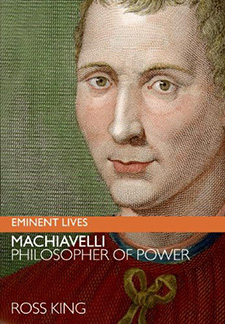 Niccolò Machiavelli, the author of The Prince—a handbook on power that is one of the most influential and controversial books ever written—was no prince himself. Born to an established middle-class family, Machiavelli worked as a courtier and diplomat for the Republic of Florence and enjoyed some small fame in his time as the author of bawdy plays and poems. In this discerning new biography, which the Times Literary Supplement has called the best introduction to Machiavelli written in English in the past fifty years, King rescues Machiavelli’s legacy from caricature, detailing the vibrant political and social context that influenced his though and underscoring the humanity of one of history’s finest and most notorious political thinkers.
Niccolò Machiavelli, the author of The Prince—a handbook on power that is one of the most influential and controversial books ever written—was no prince himself. Born to an established middle-class family, Machiavelli worked as a courtier and diplomat for the Republic of Florence and enjoyed some small fame in his time as the author of bawdy plays and poems. In this discerning new biography, which the Times Literary Supplement has called the best introduction to Machiavelli written in English in the past fifty years, King rescues Machiavelli’s legacy from caricature, detailing the vibrant political and social context that influenced his though and underscoring the humanity of one of history’s finest and most notorious political thinkers.
‘A convincing portrait of one of the most misunderstood thinkers of all time … King’s book is everything a short biography should be and more, thanks to King’s sharp wit and zesty anecdotes … A riveting and exhilarating read, full of salacious details and brisk prose.’
—Publishers Weekly (starred review)
‘While “Machiavellian” has become a common epithet, Niccolò Machiavelli himself remains an indistinct figure, a situation Ross King aims to rectify by casting a vivid light on the controversial political philosopher … [He] knows the period inside out and works overtime to bring this intriguing figure to life.’
—Boston Globe
‘A scholarly examination of hot-blooded political intrigue to rival all those potboilers on the fiction lists … In this sympathetic new biography, rich with colourful anecdote, King puts flesh on the serpent’s bones.’
—Montreal Gazette
Purchase from Amazon.com, Amazon.co.uk, Barnes & Noble or Bookshop.org
The Judgment of Paris: The Revolutionary Decade That Gave The World Impressionism
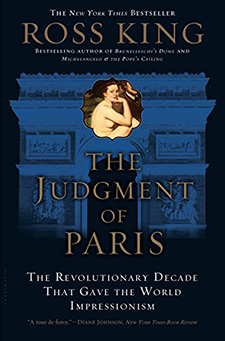
The Judgment of Paris tells the story of two very different painters. In 1863, the French painter Ernest Meissonier was one of the most famous artists in the world. The darling of the Paris Salon—that all-important public art exhibition—he painted historical subjects in meticulous detail and sold his works for astronomical sums to collectors who included the Emperor Napoleon III. Édouard Manet, on the other hand, was struggling in obscurity. Famous today as the father of Impressionism, he was once known only as the painter of a few much-derided canvases depicting absinthe-drinking beggars and bourgeois gentlemen in top hats.
With his usual narrative brilliance and eye for telling detail, Ross King takes the parallel careers of Meissonier and Manet and uses them as a lens for their times. Beginning with the year that Manet exhibited his ground-breaking Dejeuner sur l’herbe and ending in 1874 with the first Impressionist exhibition, King plunges us into Parisian life—on the streets and in the corridors of power—during a ten-year period of social and political ferment. The struggle between Meissonier and Manet to get their paintings exhibited in pride of place at the Salon was not just about art, it was about how to see the world.
‘A brilliant book.’
—The Independent on Sunday
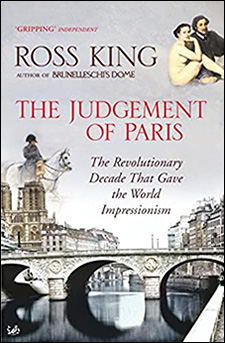
‘A tour de force.’
—New York Times Book Review
‘So thorough is King’s grasp of the Second Empire’s cultural politics, so ironic his wit and choice of detail, his text remains a page-turner throughout.’
—Los Angeles Times Book Review
‘An exhiliarating book.’
—The Independent
‘A marvelously well-structured history and a deeply pleasurable read.’
—Chicago Tribune
‘Fascinating … It makes me nostalgic for a time I have never actually experienced: a time when art and culture mattered enough to make people march in the streets.’
—National Post
Purchase from Amazon.com, Amazon.co.uk, Barnes & Noble or Bookshop.org
Michelangelo and the Pope’s Ceiling
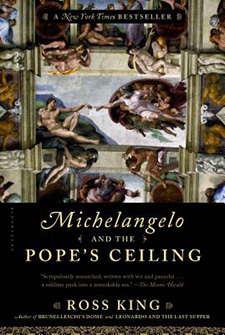
A New York Times bestseller, Michelangelo and the Pope’s Ceiling tells how Pope Julius II commissioned Michelangelo Buonarroti to paint the ceiling of the newly restored Sistine Chapel in Rome. Four years earlier, at the age of twenty-nine, Michelangelo had unveiled his masterful statue of David in Florence; however, he had little experience as a painter, even less working in the delicate medium of fresco, and none with the curved surface of vaults, which dominated the chapel’s ceiling. The temperamental Michelangelo was reluctant, and he stormed away from Rome, risking Julius’s wrath, only to be persuaded to eventually begin.
Michelangelo would spend the next four years labouring over the vast ceiling. Ross King tells the story of those four extraordinary years. From Michelangelo’s experiments with composition of pigment and plaster to his bitter competition with Raphael, who was working on the neighbouring Papal Apartments, he presents a magnificent tapestry of day-to-day life on the ingenious Sistine scaffolding and outside in the upheaval of early-sixteenth-century Rome.
‘Ross King deftly stitches modern Michelangelo scholarship into his fluent and gripping narrative. The result is a delightful book that overturns many legends.’
—The Independent
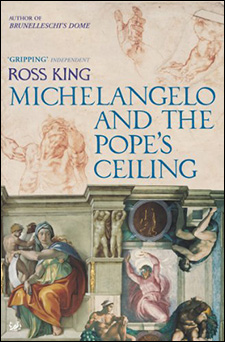
‘Scrupulously researched, written with panache, Ross King’s Michelangelo and the Pope’s Ceiling is a sublime peek into a remarkable era.’
—The Miami Herald
‘A fascinating and carefully researched account.’
—The Times
‘A narrative that never falls back on exaggeration or deviates from the facts.’
—The Sunday Times
‘Ross King expertly wipes away such smudges from the story of this great painting, only to uncover a truth even exciting and improbable … Now that art lovers can see the painting as it was originally conceived, this fabulous and eminently readable history will help them appreciate that it was no immaculate conception.’
—San Francisco Chronicle
‘Demythologises and dramatises without hectoring or debasing … King makes the familiar fresh.’
—Publishers Weekly
‘A feast.’
—The Tablet
Purchase from Amazon.com, Amazon.co.uk, Barnes & Noble or Bookshop.org
Brunelleschi’s Dome
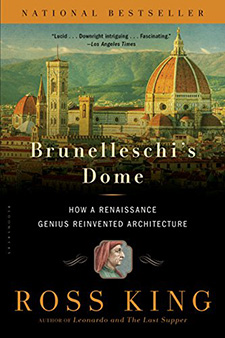 A Top-10 New York Times and No. 1 Boston Globe bestseller, Brunelleschi’s Dome is the true story of how the Florentine goldsmith Filippo Brunelleschi bent men, materials and the forces of nature to build an architectural wonder we continue to marvel at today. Denounced at first as a madman, Brunelleschi was celebrated at the end as a genius. He engineered the perfect placement of brick and stone, built ingenious hoists and cranes (some among the most renowned machines of the Italian Renaissance) to carry an estimated 70 million pounds hundreds of feet into the air, and designed the workers’ platforms and routines so carefully that only two men died during the decades of construction—all the while defying those who said the dome would surely collapse and personal obstacles that at times threatened to overwhelm him.
A Top-10 New York Times and No. 1 Boston Globe bestseller, Brunelleschi’s Dome is the true story of how the Florentine goldsmith Filippo Brunelleschi bent men, materials and the forces of nature to build an architectural wonder we continue to marvel at today. Denounced at first as a madman, Brunelleschi was celebrated at the end as a genius. He engineered the perfect placement of brick and stone, built ingenious hoists and cranes (some among the most renowned machines of the Italian Renaissance) to carry an estimated 70 million pounds hundreds of feet into the air, and designed the workers’ platforms and routines so carefully that only two men died during the decades of construction—all the while defying those who said the dome would surely collapse and personal obstacles that at times threatened to overwhelm him.
‘A wonderfully vivid little book.’
—Daily Telegraph
‘An adventure yarn set on the wild frontiers of human knowledge … abounding with excellent stories.’ —Financial Times
‘As interesting as the architect’s triumph proves, his distractions prove even more revealing about the era.’
—Newsday
‘One of architecture’s great tales.’
—Newsweek
‘Buildings are a product of the artistic imagination and building technology, but they also depend on political will and cultural capital. Ross King, a skillful storyteller, describes how all these played a role in the construction of the dome of Santa Maria del Fiore in fifteenth-century Florence.’
—Witold Rybczynski, author of The Story of Architecture, Shepherd.com
Purchase from Amazon.com, Amazon.co.uk, Barnes & Noble or Bookshop.org
Ex-Libris
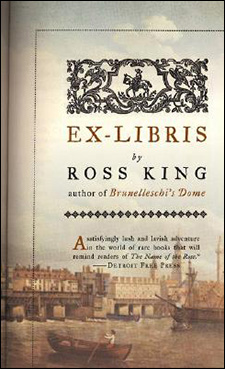
Responding to a cryptic summons to a remote country house, London bookseller Isaac Inchbold finds himself responsible for restoring a magnificent library pillaged during the English Civil War, and in the process slipping from the surface of 1660s London into an underworld of spies and smugglers, ciphers and forgeries. As he assembles the fragments of a complex historical mystery, Inchbold learns how Sir Ambrose Plessington, founder of the library, escaped from Bohemia on the eve of the Thirty Years War with plunder from the Imperial Library. Inchbold’s hunt for one of these stolen volumes—a lost Hermetic text—soon casts him into an elaborate intrigue; his fortunes hang on the discovery of the missing manuscript but his search reveals that the elusive volume is not what it seems and that he has been made an unwitting player in a treacherous game.
‘A sweeping intellectual thriller … Ex-Libris is a must for anyone who enjoyed Iain Pears’ monumental An Instance of the Fingerpost or Arturo Perez-Reverte’s magnificent The Dumas Club.’
—The Denver Post
‘An ingenious intellectual puzzle.’
—Newsday
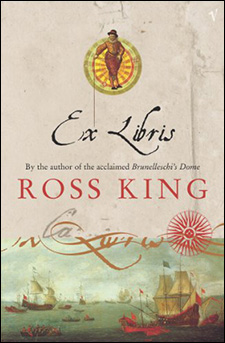
‘This book would [also] appeal to those who enjoy English language and a turn of phrase, and appreciate literary style as an artform itself.’
—The Daily News
‘A rollicking good yarn.’
—Mystery Review
‘A satisfyingly lush and lavish adventure in the world of rare books that will remind readers of The Name of the Rose.’
—Detroit Free Press
‘Entertainingly crammed with the appurtenances of Gothic romance, castles, secret codes, shadowy crypts, spies, mysterious coach rides, a distressed noblewoman, black-clad assassins.’
—Miami Herald
Purchase from Amazon.com, Amazon.co.uk, Barnes & Noble or Bookshop.org
Domino
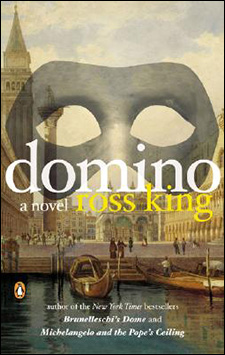
Ross King’s delightful, Rabelaisian novel recounts the adventures of young George Cautley, an aspiring artist who, as he makes his way through London’s high society, finds that nothing is as it seems and everyone wears a disguise. Moving from masquerade balls in London to the magnificent and mysterious opera houses of Venice, Cautley is drawn into a web of intrigue and murder spun by the seductive and tempestuous Lady Beauclair. Suspenseful, menacing, and laced with black humor, King’s picaresque tale is full of surprises and suspense, told at the pace of a thriller and with the richness of a restored painting.
A New York Times ‘Notable Book’, The New York Times Book Review, Christmas 2003
‘Evokes engrossingly and brilliantly the sights, smells, language and manners of late eighteenth-century London.’
—Charles Palliser, author of The Quincunx
‘A fascinating and resplendent debut.’
—Daily Telegraph
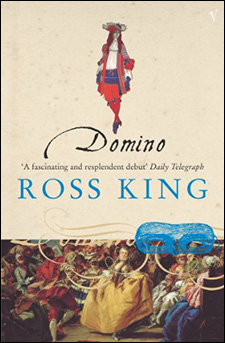
‘Delivers a seamless coup. It has the pace of a thriller and black humour slivered with superb menace … be sure to read it.’
—Spectator
‘Outlandish hats and hairstyles, towering wigs, gender-blurring masquerades—these are among the numerous excellent reasons to pick up Ross King’s Domino.’
—The New York Times Book Review
‘A rich brocade of a novel … A coming-of-age tale, a comedy of manners, a witty, penetrating and occasionally dark satire, as well as a thriller.’
—Orlando Sentinel
Purchase from Amazon.com, Amazon.co.uk, or Bookshop.org

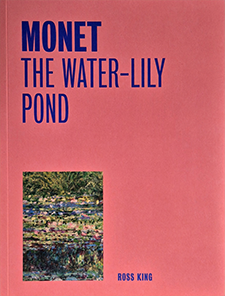 Monet: The Water-Lily Pond
Monet: The Water-Lily Pond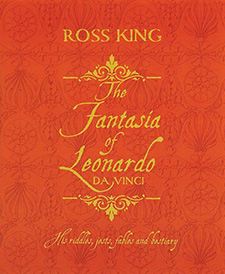 The Fantasia of Leonardo da Vinci
The Fantasia of Leonardo da Vinci